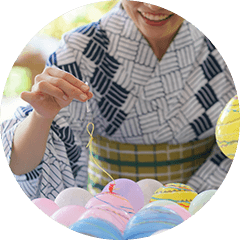For international students to live comfortably in Japan, we introduce how to use basic essential services in daily life.
We have compiled useful information that will be helpful to know at the beginning, such as how to visit a hospital, how to use public transportation, and how to shop.
Please use this as a reference to get accustomed to life in Japan.
Hospitals

Below is how to use the hospital.
- STEP1
Choosing a Hospital
-
If it's not an emergency, try searching online for "region name" + "medical department".
Hospital websites may list information such as consultation hours, how to make appointments, and whether they can accommodate English or other languages. -
* Large hospitals like university hospitals may charge extra fees if you visit without a referral letter from a clinic.
Start by visiting general clinics or smaller medical facilities.
- STEP2
Appointment and Preparation
-
Some hospitals require reservations in advance.
Check the details and make an appointment via phone or the hospital's website. - What to Bring It's helpful to bring your health insurance card, passport, a note detailing your symptoms (when they started and what they are), your medical history, and any medications you're currently taking.
- If you're worried about the language barrier, consider using an interpreter service or ask someone who understands Japanese to accompany you.
- STEP3
Consultation
- Inside the hospital, please follow the staff's instructions, fill out the questionnaire, and undergo the consultation.
- STEP4
Payment
-
You may be able to choose from various payment methods, including cash or card.
If you're unsure, it's a good idea to confirm in advance.
- STEP5
Receiving Medication
-
If a prescription is issued, go to a pharmacy that accepts prescriptions to pick up your medication.
You may be able to choose from various payment methods, including cash or card. If you're unsure, it's a good idea to confirm in advance.
Public Transportation
Trains and buses are important means of transportation that connect cities and areas within the city, making them very convenient and efficient travel options in Japan.
For international students, they will often be used on a daily basis.

The following is how to use Japanese trains and buses.
- STEP1
Ticket & IC Card Purchase
-
At the ticket vending machines installed in stations, you can select your destination and fare to purchase a ticket.
If you frequently use trains or buses, it is more convenient to get an IC card such as Suica or Pasmo.
Many stations support English and other languages. -
What’s a Suica(IC Card)? (Suica: JR East)
Purchasing a PASMO Card (PASMO) -
Be sure to charge your IC card in advance.
Suica Charge (Suica: JR East)
Topping up PASMO (PASMO)
- STEP2
Passing Through the Ticket Gate
-
If you have a ticket, insert it at the ticket gate and pass through.
For IC cards, simply tap the gate machine with your card to pass through.
- STEP3
Heading to the Platform
-
Follow the station's guide signs and the electronic display boards to head towards the platform where your train departs. Make sure to check the train's timetable and destination display.
If you use the train often, it’s convenient to install a transfer guide app.
During crowded times, be considerate of other passengers and ensure you secure a spot to board.
- STEP4
Getting on the Train
-
When the train arrives, wait for the doors to open and prioritize allowing passengers to disembark first. After that, board the train.
Inside the train, hold onto the handrails or grab handles and stand firmly, or sit in a seat.
Carry your backpack in front of you, and place large bags on the overhead shelf or move them to the side to be considerate of other passengers.
- STEP5
Getting Off the Train
-
When your destination station approaches, prepare to get off.
In some cases, you may need to press the button next to the door to indicate your stop, so check for that.
When the train stops, be mindful of other passengers and exit smoothly.
- STEP6
Exit the Ticket Gate
-
At the station where you got off, insert your ticket at the ticket gate to pass through.
If you’re using an IC card, touch it to the gate to pass through.
- STEP1
Check Bus Stops and Timetable
-
Check the bus route, destination, and operating hours, and wait at the correct bus stop.
Bus stops display the route number and destination. - *If paying by cash, large bills like 10,000 yen or 5,000 yen may not be accepted. Prepare small change or 1,000 yen bills.
- STEP2
Boarding the Bus
-
When the bus stops, greet the driver and board. If the bus is crowded, be considerate of other passengers when boarding.
There may be a front door or middle door for boarding. Please follow the announcements. -
For cash payments
Take a ticket from the ticket machine by the door.
For IC card payments
Tap your card on the reader by the door.
There may be payments upon boarding or when getting off. Please follow the announcements.
- STEP3
While Riding
-
If there is an available seat, take it. If standing, hold onto the strap or handrail to maintain stability.
Carry your backpack in front of you, and manage large luggage by placing it on the shelf or moving it to the side to be considerate of other passengers.
- STEP4
Prepare to Get Off
-
When your desired bus stop is approaching, press the exit button to notify the driver.
To avoid rushing at the last minute, check the fare and prepare your money or IC card.
- STEP5
Getting Off
-
When the bus stops...
For Cash Payment
Place the ticket and cash into the fare box at the front door of the bus to pay.
*Change can be made at the change machine by the fare box. Bills such as 10,000 yen or 5,000 yen may not be accepted for change.
For IC Card Payment
Touch your IC card on the reader at the front door of the bus.
When getting off, be sure to greet the driver and exit while being considerate of other passengers.
Shopping
Groceries and daily necessities can be purchased at supermarkets.
Medicine and cosmetics are sold at drugstores.
Large supermarkets like AEON and Ito Yokado often carry clothing and electronics as well.
Additionally, during the night, although the selection may be less extensive than at supermarkets, convenience stores are available for use.

- Cash
Cash is widely used in Japan, but credit cards and debit cards are also accepted. - Electronic Money
IC cards like Suica and Pasmo are convenient and can be used not only for transportation but also at convenience stores and some other shops. - QR Code Payments
QR code payments such as PayPay and LINE Pay have become popular recently.
- Stand in a line
In Japan, it's important to follow the line, especially at the register or bus stops. - Quietly
Try to avoid speaking loudly inside stores. - Pay Plastic Bag
To protect the environment, many stores charge for shopping bags. It's recommended to bring your own eco-bag.



